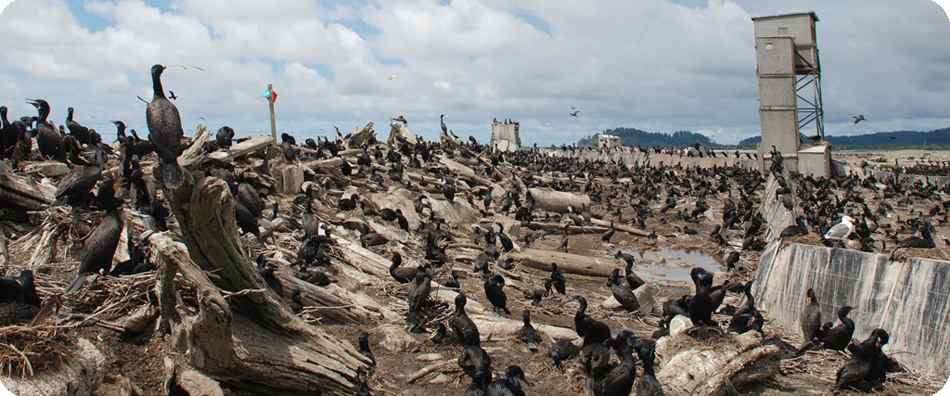forum
library
tutorial
contact

Judge Says Decision to Kill Cormorants
Unlawful, But Keeps it in Place
by Laura Berg
NW Fishletter, September 6, 2016
|
the film forum library tutorial contact |

|
Judge Says Decision to Kill Cormorants
by Laura Berg
|
 U.S. District Judge Michael Simon ruled Aug. 31 that the U.S. Army Corps of Engineers violated the National Environmental Policy Act when it authorized a plan to cull and kill double-crested cormorants in the Columbia River estuary.
U.S. District Judge Michael Simon ruled Aug. 31 that the U.S. Army Corps of Engineers violated the National Environmental Policy Act when it authorized a plan to cull and kill double-crested cormorants in the Columbia River estuary.
However, although Simon concluded that the agency had not considered alternatives to killing the birds, he left the Corps' cormorant plan in place.
The birds prey on juvenile salmonids in lower reaches of the Columbia River.
"The plan provides some benefit to salmonids that are listed as endangered or threatened under the Endangered Species Act, whereas double-crested cormorants are not listed as either endangered or threatened," the judge wrote.
The cormorant plan was one of the actions, or reasonable and prudent alternatives (RPAs), included in the 2014 BiOp to avoid jeopardy in operating the federal power system.
The plan involved killing 10,912 adult cormorants, and oiling and destroying a total of 26,096 nests over a four-year period.
The plaintiffs in the case, Audubon Society of Portland et al. v. U.S. Army Corps of Engineers [15-cv-00665], called for an end to "the needless slaughter," arguing, "the continued killing of the birds and destruction of their nests may send cormorant populations below sustainable levels."
In addition to the Audubon Society, plaintiffs are the Wildlife Center of the North Coast, Animal Legal Defense Fund, Center for Biological Diversity and Friends of Animals.
The Corps, U.S. Department of Agriculture Wildlife Services, U.S. Fish and Wildlife Service, Northwest RiverPartners and four amici curiae tribes--the Colville, Umatilla, Warm Springs and Yakama--are the defendant parties.
In the Aug. 31 decision, the court ruled in favor of the plaintiffs on one claim--that the federal defendant failed to properly consider a range of reasonable alternatives--and in favor of defendants on 11 other claims.
The results of a preliminary study by the U.S. Fish and Wildlife Service provided the basis for an important assertion by the plaintiffs.
The study said that getting rid of cormorants would provide minimal benefits to salmon abundance, as most of the juveniles not eaten by cormorants would die later for other reasons.
The study called this phenomenon compensatory mortality, and the judge decided "the science is uncertain regarding the precise effect of compensatory mortality on cormorant predation of salmonids."
In rejecting this argument, Simon also said, "The analysis relied on by Plaintiffs was an internal draft analysis that had not yet been finalized or undergone peer review or other study."
RiverPartners and amici parties asserted that plaintiffs' NEPA claims were no longer germane because the court had ordered an environmental impact statement in the FCRPS 2014 BiOp case.
The upcoming EIS (see story 1) will likely consider actions, including the cormorant plan, to limit bird predation on listed salmonids.
In a news statement, the groups that brought the lawsuit said they would continue to "vigorously oppose the further killing" of cormorants on East Sand Island near the Columbia River mouth.
Tanya Sanerib, an attorney at the Center for Biological Diversity, said they thought the judge's ruling was "an important first step in getting our federal agencies to look at alternatives and the science behind them, and address the real threat to salmon: the dams"
Related Pages:
Killing Cormorants Did Little to Help Salmon, Judge Hears by Karina Brown, Courthouse News, 6/6/16
Conservation, Animal Welfare Groups File Lawsuit to Stop Plan to Cull Estuary Cormorants by Staff, Columbia Basin Bulletin, 4/24/15
Audubon Announces Intent to Sue Over Plan to Cull Cormorants from Columbia River Estuary by Staff, Columbia Basin Bulletin, 3/27/15
USFWS Grants Corps One-Year Depredation Permit To Begin Culling Columbia Estuary Cormorants by Staff, Columbia Basin Bulletin, 4/17/15
Audubon Announces Intent to Sue Corps Over Plan To Cull Cormorants From Columbia River Estuary by Staff, Columbia Basin Bulletin, 3/27/15
Final EIS Released On Reducing Estuary Cormorant Numbers; Proposes Both Shooting And Egg Oiling by Staff, Columbia Basin Bulletin, 2/6/15
learn more on topics covered in the film
see the video
read the script
learn the songs
discussion forum
